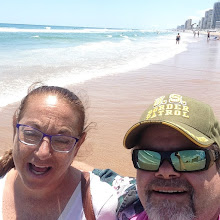Where I come from, when you say brand, people immediately think about a dusty corral with a large group of new calves just brought down from the foothills huddling in one corner. Someone ropes the closest calf, drags him out into the middle of the pen close to a small fire with a couple iron handles sticking out of it. The calf is thrown onto his side, castrated, then the hot iron is pressed against his fleshy backside muscles. Antiseptic salve is applied to all his new wounds, he's given an injection, an ear tag is clipped on, then he's released to scamper back to the group.
No wonder they are huddled tightly in the corner.
This brand becomes a visible scar that the animal wears for the remainder of his short life before he becomes a freezer full of juicy hamburger, steaks, roasts and sausage.
When you think about branding a business, the process is not nearly as cut and dried, pun intended.
A brand is much more than a symbol that you hope people will recognize and associate with your product or service. To build a brand you have to be ready to invest time, money and research.
First, you have to answer a few questions.
What do you know about your customers?
Where does your company fit into their needs and wants?
What makes you different from your competitors?
Create a picture in your mind of the ideal target customer.
What do they wear? Where do they live? What do they eat? Where does their money come from? What outside influences impact their daily lives?
Ok, now develop a slogan, or individual selling statement (ISS).
Your ISS has to offer a solution for your customers.
It has to offer them a perceived value.
It has to imply that you are the ONLY solution out there.
Once you have an ISS in mind, it's time to develop a logo. This is what you are going to burn into your company's ass to make it instantly recognizable to your customers.
The logo has to create a clear idea or image about your company that must be consistent with your ISS.
The visual brand is not just your logo. It is the colors you select and the font you choose to use.
Now it's time to build your reputation. Customer service, value and more customer service are the keys.
You don't necessarily have to have the best prices to build a successful brand. Companies like Starbucks, Krispy Kreme, BMW and Macintosh all built successful brands around products that were much more expensive than their competitors. They built a brand around superior and specialized products that gave customers a good feeling when they shelled out twice the going price for their products.
For their customers, price point implied quality, status and good taste.
Other companies centered their brands around value. Wal-Mart, PayLess Shoes, and, in the beginning of their onslaught on the American car market, Toyota and Datsun (Nissan) offered cheaper products. Their brands were built through a growth of trust and credibility. Smaller businesses can use the same concepts. The steakhouse/cantina downtown can create a brand by making his place become the spot to be seen among the local movers and shakers. By the same token, the sandwich shop on the corner can build a brand around affordable, fast lunches for the working class.
Once you have started down the road to branding you have to go back to marketing basics. You have to advertise and attract business. The primary branding rule in visual and audio advertising is to keep your message consistent. In order to do this you have to be absolutely certain that you have created the brand that's going to work for you. You can't be consistent if you keep changing the message, or fonts or brand colors or ISS.
Keep the branding message consistent. Offer consistently excellent customer service and provide a product or service that's relevant to your customers.
In other words, don't slip when applying the iron, make sure the cuts are clean, make sure the calves have plenty to eat, their water's clear, and your fences are tight.
Subscribe to:
Post Comments (Atom)

No comments:
Post a Comment